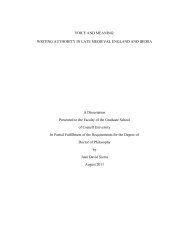CARPET WEAVERS AND WEAVING IN THE ... - Cornell University
CARPET WEAVERS AND WEAVING IN THE ... - Cornell University
CARPET WEAVERS AND WEAVING IN THE ... - Cornell University
You also want an ePaper? Increase the reach of your titles
YUMPU automatically turns print PDFs into web optimized ePapers that Google loves.
manufactured goods both in the world market and in their own communities. “Craft<br />
production can serve as either a haven from or a source of capitalist development”<br />
(Stephen 1991, 394). Artisans become dependent on faraway markets (Nash 1993, 13),<br />
but can also maintain their households through a combination of subsistence farming<br />
and craft production. Crafts are bought either because they are cheap and utilitarian or<br />
“because of their symbolic representational or esthetic status (which may inflate their<br />
value in price terms and put them into the “luxury” category)” (Cook 1993, 60).<br />
Increase in disposable income leads to improved health and dental care; diet<br />
also improves (Colloredo-Mansfeld 1999, 201). Colloredo-Mansfeld found that one of<br />
two men in Ariasucu, Ecuador, still weaving cloth to make garments with a 600-year<br />
history does so to pass the time while watching MacGyver (and in this way the TV<br />
bought with cash income is helping to preserve a traditional craft). As will be shown<br />
later, in the discussion of Turkish weavers, artisans in this region use weaving as a<br />
way of being productive during “leisure” time. Stereos, bought with cash generated<br />
by craft production, also “make a shop happy,” thus helping managers retain weavers;<br />
likewise, having appliances in the home allows women time away from chores to<br />
work commercially (Colloredo-Mansfeld 1999, 180-185).<br />
There are (and have been throughout history) a huge number of forms of<br />
production and exchange involved in the craft market (Cook 1993, 60); any one place<br />
can have one or many production levels (high-end, middle, and low) at any given time<br />
(Stephen 1991, 385). In many rural areas the household needs to engage in various<br />
combinations of production (wage labor, and home-based industry, share-cropping and<br />
wage labor etc.) in order to produce subsistence, with all members of the household<br />
involved – thus “no single individual is able to guarantee her or his survival” and<br />
“women are not housewives, dependent on the income of their husbands: they are in<br />
6

















